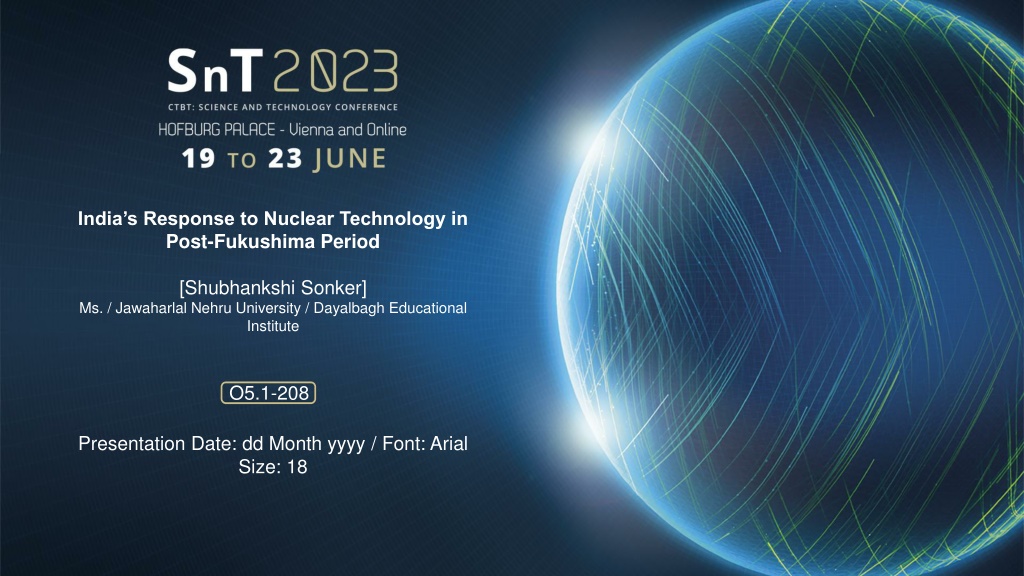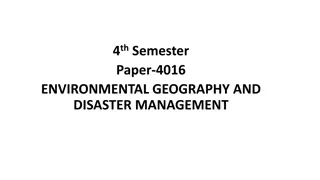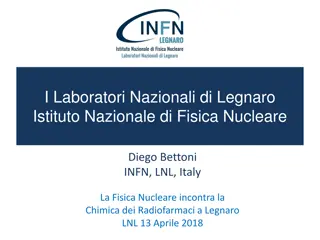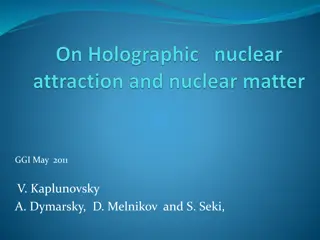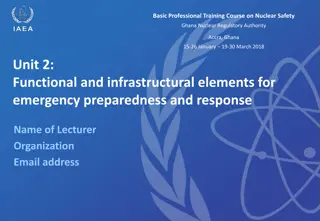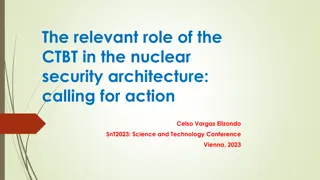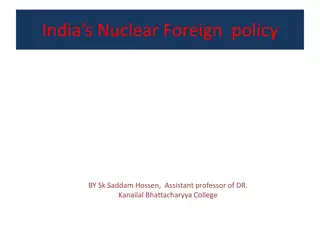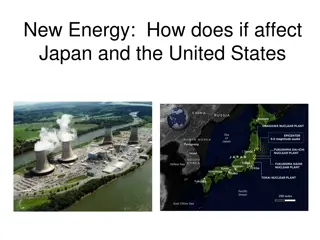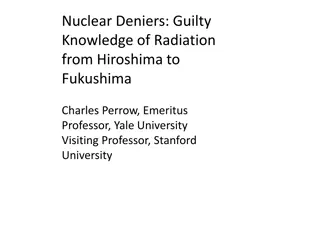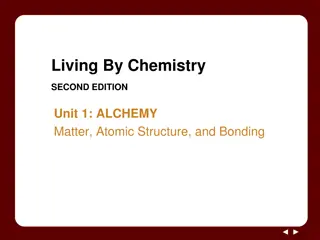India's Response to Nuclear Technology in Post-Fukushima Period
Fukushima disaster has sparked a paradigm shift in global attitudes towards nuclear technology, leading to public protests and decreased confidence in nuclear energy. This study explores the impact of Fukushima on public understanding of nuclear technology in India, focusing on responses from various groups including youth, residents of Kudankulam, and government institutions. It examines the evolving discourse through the lens of Public Understanding of Science perspective, highlighting the need for public engagement to address trust deficits and misconceptions related to scientific institutions and technologies.
Download Presentation

Please find below an Image/Link to download the presentation.
The content on the website is provided AS IS for your information and personal use only. It may not be sold, licensed, or shared on other websites without obtaining consent from the author. Download presentation by click this link. If you encounter any issues during the download, it is possible that the publisher has removed the file from their server.
E N D
Presentation Transcript
Indias Response to Nuclear Technology in Post-Fukushima Period [Shubhankshi Sonker] Ms. / Jawaharlal Nehru University / Dayalbagh Educational Institute O5.1-208 Presentation Date: dd Month yyyy / Font: Arial Size: 18
INTRODUCTION O5.1-208 Fukushima has become a turning point in the world history of nuclear technology. The relationship between technology, society, politics, and environment has come into sharp public discourse. One can rightly call it a paradigm shift, which appeals for new knowledge and new interpretation (Rieu, 2012). The global renaissance, vouched for years, has ultimately failed to materialize in the light of Fukushima disaster and there is receding confidence in the argument that nuclear energy is the safest and futuristic energy solution. Moreover, countries like Germany, Switzerland, China and even Japan have decided to phase out of nuclear power as immediately as possible (Netzer and Steinilber, 2011). In the wake of Fukushima, there have been severe protests against the nuclear technology worldwide. Countries like US, France, China, Japan, India, witnessed severe public discontent against national nuclear energy programmes. In the context of India, protest against the nuclear power is not new, though it has remained at fringe, however, after Fukushima, Kudankualam(Tamil Nadu) and Jaitapure(Maharashtra) have emerged as new cites of protest. India s nuclear technology has been a matter of colossal secrecy, since its very inception. Public participation has never been fully endorsed and appreciated in national nuclear planning and policy making. The nuclear energy establishment was almost sacrosanct, the technology a passport to modernity. In many ways the government was relatively successful in mobilizing the public opinion towards its pro-nuclear policies on the basis of energy demands couple of years back at the tenure of UPA II. However, in the few months after the Japanese nuclear disaster, the situation has dramatically changed.
Place your Logo here after removing this text box! PUBLIC UNDERSTANDING OF SCIENCE O5.1-208 In the current study, India s Response to Nuclear Technology in Post Fukushima Era, the main thrust would be to comprehend how the Fukushima disaster has given rise to new discourse, its impact on public understanding, how people s perspective has gained significant impetus and how people conceptualize the whole tenor of nuclear technology. In the study emphasis has been given to responses of different public(s) like Youth, inhabitants of Kudankulam and Government Institutions. Study also tries to explore, how different public/actor(s) interact within each other and how simultaneously they operate at individual level and group level. One of the salient features of this study is that post- Fukushima disaster has been studied through the lens of Public Understanding of Science perspective and study has tried to see how burgeoning brawl between science, scientific institutions, state and common masses can be addressed through the prism of Public Engagement Model. Public understanding of science (PUS) is not only young and emerging discipline, but a modern movement which tries to rejuvenate sense of trust among ordinary citizens (Finkelstein, 1996) to counteract or simply contest the trust deficit and misconceptions pertaining to scientific institutions, innovations, newer technologies, scientific applications and actions (Boykof, Roberts. 2007). Rader (2011) expresses it as a kind of activism, which tries to generate public opinion and simultaneously ensure their participation in diverse scientific ventures.
PUBLIC UNDERSTANDING OF SCIENCE (DIFFERENT MODELS OF PUS) Place your Logo here after removing this text box! O5.1-208 More interestingly, (Durant, 2003) suggests that PUS now focuses on dialogue model rather than deficit model. (Schafer, S. Mike. 2009) Public understanding of science is like any other social phenomenon, which not only talks of factual details but comprises of social discourses (Martin Bauer 2009). Within the broader framework of PUS, the study would try to conceptualize, what is, People s response to nuclear technology in post Fukushima era. The study has heavily relied on the public engagement model. It tries to emphasize, how different publics are coming together or, how they interact with each other in order to form a mechanism, whereby it ensures participation and interaction among all of them. Having said that, the study would be highlighting how different actors like media, youth and community people can come together to build a mechanism of participation. DEFICIT MODEL: In order to bridge the gap between layman and scientific institutions, it is believed that there is a huge gap of knowledge and in order, to fill the gap and commune the basic scientific knowledge to general masses, we require an approach known as deficit model (Lewenstein, 2003). Most notably, many of the questions are asked without providing a context (Wynne, 1995) in deficit model. CONTEXTUAL MODEL: The model takes care that individuals or respondents are not mere treated as empty containers but should be given ample space to process the information according to their socio-cultural and political backgrounds. Thus, information is received from respondents located in specific contexts. Contextual models have been criticized for being merely more sophisticated versions of the deficit model.
PUBLIC UNDERSTANDING OF SCIENCE (DIFFERENT MODELS OF PUS) Place your Logo here after removing this text box! O5.1-208 LAY EXPERTISE MODEL: It begins with local knowledge, sometimes called layknowledge or layexpertise (Wynne, 1989). This model argues that scientists are often unreasonably certain even arrogant about their level of knowledge, failing to recognize the contingencies or additional information needed to make real world personal or policy decisions. Basing their analyses largely on case studies (Irwin & Wynne, 1996), proponents of a lay knowledge approach argue that communication activities need to be structured in ways that acknowledge information, knowledge and expertise already held by communities facing scientific and technical issues (Wynne, 1996). THE PUBLIC ENGAGEMENT MODEL: It focuses on array of activities, initiated to foster public participation in science policy. These activities include consensus conferences, citizen juries, deliberative technology assessments, science shops, deliberative polling, and other techniques (Hamlett, 2002), (Wachelder, 2003). Moreover, public engagement model tries to ensure democratization of science, taking control of science from elite scientists and politicians and hand over it to various public groups, in order to ensure their participation and engagement in various scientific endeavors (Sclove, 1995). It is believed there is deficit of trust, not with public but with scientific institutions and the actors. False conceptions of the public operate among scientists in policy making, that is deficit concept of the public and these misguide communication efforts and interventions and alienate the public further. Rebuilding of public trust is the immediate need between the disenchanted public and institutions of science, industry and policy makers (Bauer, 2009)
Figure 1(Lewenstein, 2006) PUBLIC UNDERSTANDING OF SCIENCE (DIFFERENT MODELS OF PUS) Place your Logo here after removing this text box! O5.1-208 Wynne remarked, Public understanding of science (PUS) is a wide and ill-defined area involving several different disciplinary perspectives (Wynne, 1992). In the context of science education, Millar(1999) proposed three aspects of understanding of Science that may be generalized to concisely define the public understanding of science as: 1) Understanding of science content, or substantive scientific knowledge (known as content) (Chet, 1998). 2) Understanding of the methods of enquiry (so-called process) (Durant, 1989). 3) Understanding of science as a social enterprise. (Awareness of the impact of science on individuals and society; an extensive dimension summarized by the label of social factors) (Stang, 2010). PUS STUDIES IN INDIA: Public understanding and perception about S&T has been a relatively unexplored area of study in India. The existing surveys carried out on the subject are only indicative but not representative in nature (Shukla, 2005). It was an indigenous movement which developed and nourished in Indian context. And after independence, there was huge impetus in spreading out scientific knowledge to lay public. In 1962, KSSP Kerala Sastra Sahitya Parisad was a huge progress in terms of communicating scientific information. In 1987, after serious reflections a small group of scientists was constituted in National Institute of Science, Technology and Development Studies (NISTADS-CSIR), with the primary objective of carrying research on attitudes and public understanding of science. According to Gauher Raza, international meet which took place at New Delhi, 2008 mapped the scientific consciousness as a step towards taking stock of developments, gap areas and future trends. Raza argues that, in 19th century, scientific community had developed a style of its own, which was too comprehensive for the general public to understand.
Figure 1(Lewenstein, 2006) PUBLIC UNDERSTANDING OF SCIENCE (DIFFERENT MODELS OF PUS) Place your Logo here after removing this text box! O5.1-208 Source: Lewenstein, 2006
Figure 1(Lewenstein, 2006) PUBLIC UNDERSTANDING OF SCIENCE (THE CASE OF NUCLEAR TECHNOLOGY IN INDIA) Place your Logo here after removing this text box! O5.1-208 Nehru from the very beginning favored technological sophistication and intensely advocated for technological intervention to achieve the dream of universal development. He believed lack of technology was accountable for colonization of India. Nehru always asserted that the new nation state should be produced and narrated through science and technology. Thus, atom as well as scientific knowledge was very central to Nehru s dream of modern India (Abrahim, 1998). Bhabha, who returned to India in 1939, was perhaps the apt person for Nehru to build the modern nation on scientific lines (Perkovich, 1999). In 1946 the atomic energy research committee was formed under the chairmanship of Bhabha. Through the Tata institute and the atomic research committee, Bhabha sought to modernize India by cultivating the talent and knowledge required to master the most advanced field of science and technology at the time, atomic energy. During the 1948 constituent assembly debate on atomic energy, Nehru tried hard to produce perfect rationale for India s atomic energy program, and it seems he himself was dual in his approach (Abrahim, 1998) I don t know how you are to distinguish between the two (peaceful and military use of atomic energy ), and of course if we are compelled to use (atomic energy) for other purposes , possibly no pious sentiments of any of us will stop the nation from using it that way. But I do hope that our outlook in regard to this atomic energy is going to be peaceful one and not one of the hatred (Chengappa, 2000). Author Abrahim(1998) traces down visible shifts in India s atomic programme from peaceful to military purposes and all significant role played by First Prime minister of India, Pandit Nehru in construction of nuclear India.
Figure 1(Lewenstein, 2006) PUBLIC UNDERSTANDING OF SCIENCE (THE CASE OF NUCLEAR TECHNOLOGY IN INDIA) Place your Logo here after removing this text box! O5.1-208 Myriad factors could be held responsible for India going as nuclear. Primarily geo-politics, national security, recognition of nucleus scientific community and the prestige of being a post-colonial indigenous project substantiated by other domestic factors like energy demands to build a modern independent state (Anderson, 2010). K Subramanian, one of the foremost security experts explains in his view, Such weapons are currency of power the million-pound note that would never be cashed and which allow India to be a player not an object of this global nuclear order (Anderson, 2010)
Figure 1(Lewenstein, 2006) PUBLIC UNDERSTANDING OF SCIENCE (YOUTH S RESPONSE TO NUCLEAR TECHNOLOGY) Place your Logo here after removing this text box! plants. (See figure 2.) O5.1-208 In the current study, it was observed that 53.3% of respondents share the opinion that, nuclear power plants in India are prone to threat of earthquakes and thus seismic sensitivity is top concern for the safety of nuclear power plants. 42.7% respondents voted for the option of faulty design. The next option, for which maximum number of responses were received, after earthquakes and faulty design, was meltdown. 32.7% of respondents think nuclear power plants are not safe and massively dangerous because of the risk of meltdown. In the study carried out by IEA (2005), the majority, 54%, of respondents surveyed, vouched that, the risk of terrorism is high. In the case of India, it was observed that, 40 % of Indians consider terrorism as primary risk for safety of nuclear power plants. However, in the present study it was found that only 22% of respondents conjure up terrorism or terrorist attacks as primary danger for the nuclear power plants. Only, 14% of respondents, support floods as the potential risk for Indian nuclear power plants.
Figure 1(Lewenstein, 2006) PUBLIC UNDERSTANDING OF SCIENCE (YOUTH S RESPONSE TO NUCLEAR TECHNOLOGY) Place your Logo here after removing this text box! plants. (See figure 2.) O5.1-208
Figure 1(Lewenstein, 2006) PUBLIC UNDERSTANDING OF SCIENCE (YOUTH S RESPONSE TO ALTERNATIVE SOURCE OF ENERGY) Place your Logo here after removing this text box! plants. (See figure 2.) O5.1-208 In a very important study (CAN, 2011), it was observed that 76% of the respondents claim that they strongly favor solar energy as the most reliable and effective source of energy in contrast to the nuclear energy. Also, 64% of the surveyed public strongly favored wind as the most reliable choice of energy in the post Fukushima era. 55% of the respondents vouch for hydroelectric option and surprisingly a very meager proportion of people suggest coal as their strongly selected energy alternative. In current study, it was found that 53.3% respondents said that solar energy is highly important and simultaneously the most reliable option of energy, while 14% of respondents believe that solar energy is not that important. Hydroelectricity is the second most reliable option of energy, and 34% claim hydroelectricity is highly important, while 32% of the respondents hold opposite opinion. 32.05% of the people questioned replied that they believe coal is highly important and the other 12.7% assume that coal is not important at all. Bio energy as a highly important option was chosen by 30.7% respondents and interestingly a higher number of respondents, 34.3% rightly denied its importance. 20.7% conceive that wind could be the alternative for nuclear energy and almost double of the respondents 40% denies the claim that wind is highly important and reliable option of energy.
Figure 1(Lewenstein, 2006) PUBLIC UNDERSTANDING OF SCIENCE (YOUTH S RESPONSE TO ALTERNATIVE SOURCE OF ENERGY) Place your Logo here after removing this text box! plants. (See figure 2.) O5.1-208
Figure 1(Lewenstein, 2006) plants. (See figure 2.) PUBLIC UNDERSTANDING OF SCIENCE (YOUTH S RESPONSE TO SIGNIFICANCE OF PUBLIC OPINION) Place your Logo here after removing this text box! O5.1-208 In the current study it was found that, 81.3 % of total respondent believe that public opinion regarding nuclear technology in post Fukushima period is significantly important and only fewer, 18.7% questioned people assume that public opinion is not important. Thus, one can claim that a huge chunk of population holds public opinion utterly important in policy matters in the post Fukushima era. When the question was asked that, is it too dangerous to leave policy and decision-making matters to only technical experts relating to high and new technologies such as nuclear, stem and nano etc. In reply to this question, 46 % of the respondents chose that civil society is not given adequate space, decision making should be highly transparent. 36% of the respondents refuted their argument and chose the option that doesn t agree with the posed question; thus, they strongly favor the claim that policy matters should be dealt exclusively by the experts. However, 24% of the respondents believe that civil society should be given enough space to operate. In the other way round one can assume that despite holding civil society important for decision making. Still, a good number, 46%, of respondents believe that decision making is not merely the matter of experts and domain pertaining only to civil society, but the ordinary or layman do have a share in decision making and policy framing. In yet another important question that, after Fukushima, India should conduct serious assessment on the future of nuclear technology. Majority of the questioned public, 88%, believe that, yes there should be serious assessment on the future of nuclear energy and very merge 12% people refuted their argument. When asked what the outcome of such an assessment should be, surprisingly 55% answered, we cannot give up nuclear technology; safety measures should be urgently introduced in all existing nuclear power plants and eliminates public fear.
Figure 1(Lewenstein, 2006) plants. (See figure 2.) PUS:YOUTH S RESPONSE TO ASSESSMENT ON FUTURE OF NUCLEAR TECHNOLOGY Place your Logo here after removing this text box! O5.1-208 29% of the respondents chose that, nuclear power plants are prone to natural disasters and hence India should consider closing nuclear power plants, which are more than 25 years old or as per international norms adopted by some leading countries like Japan and Germany. Similarly, 20% of respondents believe that India should reduce reliance on nuclear power plants and declare complete moratorium on building new nuclear power plants and 18% of the respondents conceive that, the regulatory and assessment bodies should become completely autonomous and be made transparent to public scrutiny including CAG (audit). In the study, it was found that 60% of the people believe that government should not give green signal to Koodankulam nuclear power plant, in the wake of huge public unhappiness and discontentment. The rest of the 40% believed that government should go ahead with Kudankulam nuclear plant, despite so much of hue and cry by the inhabitants of Kudankulam and surrounding villages. 34 % of the respondents assumed that Kudankulam crises would be resolved only when public discontent is addressed. 30% of the respondents believe residents around Kudankulam nuclear power plant should be rehabilitated, then only government should commission nuclear power plant. 26% of the questioned public answered that, government should provide employment to the people residing around nuclear power plant and fewer assume that leader should be allowed to have dialogue with the government, to settle the Kudankulam issue. Thus, addressal of public discontentment seems to be the point of centrality, when we look for Kudankulam resolution.
Figure 1(Lewenstein, 2006) plants. (See figure 2.) Place your Logo here after removing this text box! PUS:YOUTH S RESPONSE TO MEDIA COVERAGE O5.1-208 40% of the respondents chose the option that nuclear tragedies are strongly exaggerated by the media, 15.3 % of the respondents chose that nuclear tragedies are underestimated during media coverage. However surprisingly, an equal number 15.3% of respondents believed that nuclear episodes are correctly portrayed by media. While 19.3 % of the respondents chose don t know, when asked about their perception on media s coverage of nuclear tragedies. Thus, one can interpret from the above observation that our youth is widely divided on the opinion when it comes to media coverage of nuclear episodes. Though a good number of respondents believe that media exaggerates and sensitizes the occurrence of nuclear tragedies. But sizable numbers of respondents share other opinions and believe that nuclear episodes are correctly projected by media.
Figure 1(Lewenstein, 2006) plants. (See figure 2.) Place your Logo here after removing this text box! PEOPLE S UNDERSTANDING OF NUCLEAR TECHNOLOGY O5.1-208 People of Kudankulam are well aware about the nuclear incident that has happened in the past. They not only remember the dates, but they offer sufficient details about the nuclear tragedies that have happened in the course of history like Chernobyl, Three Mile Island and now Fukushima. In a sense they historicize the nuclear episodes, while framing their understanding of risk and safety pertaining to nuclear technology . People refer to historical nuclear tragedies including Hiroshima and Nagasaki. They also talk about Bhopal gas tragedy and Kalpakkam nuclear incident. They argue that children still are born with innumerable deformities; they are still suffering from cancer and other diseases, severe genetic disorders and on the top of that effected people are yet to receive compensations, which simply speaks callous attitude of concerned state governments. Nuclear power plant is not a matter of one single year, it is about future generations. People not only from Kudankulam, but other villages share the same content that we cannot live in persistent fear, fear of massive explosion, pervasive radiations and unbelievable aftermaths. Nobody knows what is going to happen in future, so how they (NPCIL) can assure that our life and future is protected. People argue that huge deposits of uranium would be dumped in the near vicinity. It would be nothing but a dumping ground, which by all measures is a point of concern, grave issue and a matter of protest. They believe nuclear plant requires huge amount of water, which would be de-salinated and then consumed for cooling purposes. In exchange almost, 7. 2 billion liters of hot water would be discharged every day from every single nuclear plant, such a great quantity would ultimately depreciate water texture and water contamination would be the bothersome matter for marine ecology. Tamil Naidu is facing enormous water scarcity and states like Kerala and Karnataka are not in any compromise of sharing water with Tamil Naidu.
Figure 1(Lewenstein, 2006) plants. (See figure 2.) Place your Logo here after removing this text box! PEOPLE S UNDERSTANDING OF NUCLEAR TECHNOLOGY O5.1-208 People believe Tamil Nadu is self sufficient, when it comes to electricity consumption. Tamil Naidu can sustain if it is able to construct solar roofs throughout the entire region. Tamil Naidu gets sunlight for more than 320-340, so confessedly Tamil Naidu has a huge potential for solar energy, unlike northern India. Moreover, maintenance cost in case of solar energy is not that high, when we compare with nuclear energy. In case of nuclear energy, uranium is purchased from other countries. Nuclear energy requires huge economic investment, large labor force and vast infrastructure; still there is no assurance of electricity. Moreover, in Germany there is a village which is completely electrified through solar energy, when Germany is receiving sunlight for 180-200 days, which is by any evaluation is lesser than us (India) do receive. In addition to solar, wind is another important source of energy, nearly 3000Mwt of energy is generated from wind energy only, and it could be further enhanced, if government facilitates wind technology and taps it properly. From the feministic point of view, one can conceptualize nuclear protest more thoroughly. Joint family would never remain intact, because it would be displaced if the nuclear power plants are commissioned. This is what felt by some in the region. It is the women who experience a lot of dilemma, if the children are born with deformities, it would be the female members who need to run from one doctor to another to get their children cured.
Figure 1(Lewenstein, 2006) plants. (See figure 2.) Place your Logo here after removing this text box! SCIENCE-SOCIETY CONFLICT O5.1-208 Kudankulam is more of science-society conflict, rather than calling it unrealistic dissent based on emotional content and false conceptions. People are opposing science which they believe is violent, pervasive and hegemonic. It is directive and denies the imperativeness of socio-cultural contexts. People argue technology, which NPCIL authorities claim to be more sophisticated, meant to withstand any natural or human calamity, is the similar to one, used in Chernobyl. Russia disowns this technology and India is determinant to buy the spare parts. Technology developed in different culture and conditions cannot be hold appropriate for Indian culture, what suits them is not mandatory will suit on this soil too, people deny the expansion of nuclear power plants and substantiate with similar kind of arguments. People stress they have all the right to know science and raise question on various scientific institutions. People are ardent to know what is going to happen with electricity, and what nuclear power plants are all about, because it determines their future and safety. Science is not only the domain of scientists; common masses can acquire knowledge too, because ultimately science has to think of goodwill of entire society, rather than being impunity of few. One of the naked truth is that Kudankulam power plant is located at a distance of half a kilometer from Tsunami colony, and there is more than 1 lakh people residing within a 16 km radius, which utterly is great violation by NPCIL against the established AERB rules. (in a 16 km radius, population must not exceed10,000 residents as per AERB Rules).
Figure 1(Lewenstein, 2006) plants. (See figure 2.) Place your Logo here after removing this text box! SCIENCE-SOCIETY CONFLICT O5.1-208 People also raise question on the autonomy of AERB and DAE. They know that AERB has to report to the Secretary, DAE, who is also responsible for the Nuclear Power Corporation of India Limited (NPCIL), which executes nuclear power program. Thus, the promotion and safety regulation are both in the hands of the DAE. In the whole discourse of Kudankulam issue, point which secures merit is that Kudankulam has been a hotbed of protest since 1989, when the nuclear project was in its conceptual stage. From last two decades and more, people s apprehensions were never addressed with sincerity and their perception on nuclear technology, risk, safety, and livelihood remained unaltered as dangerous and uncertain explosive neighbors. It is only when the mass agitation gained momentum specifically in the wake of furious Fukushima accident, scientific community has got out of deep slumber and has almost left no stone unturned to assure frightened and aggressive masses about the safety and stability of nuclear power plant. In nutshell lack of proper conscientization and awareness regarding the project has spurted out an acumen problem for scientific community. People s attitude and knowledge regarding much contested nuclear technology need to be reconstructed as early as possible. Government as well as scientific institutions needs to be more serious about public participation and popularization of science.
Figure 1(Lewenstein, 2006) plants. (See figure 2.) Place your Logo here after removing this text box! SCIENCE-SOCIETY CONFLICT O5.1-208 PUS as a discipline and tool most be employed to regenerate the lost and waning public trust. Moreover, it is pertinent on the part of scientific community and scientific institutions to understand under which conditions, and in which form the general public assimilate scientific background knowledge, thus PUS discipline need to take care of vernacular knowledge and belief system as well, before making common public as part of scientific ventures and projects. Thus, Kudankulam Nuclear project controversy is witness to severe policy lapse, which surely is a point of concern for one and all. Moreover, over riding public opinion has resulted in staunch and rabid opposition to nuclear technology in current times. Thus, the post Fukushima period call for more space and respect to public opinion, if public participation is really a serious concern, then it demands ample space and earliest attention.
Figure 1(Lewenstein, 2006) plants. (See figure 2.) Place your Logo here after removing this text box! GOVERNMENT S RESPONSE POST-FUKUSHIMA O5.1-208 When the discourse rekindled on the safety and future of nuclear power plants in India in the wake of devastating earthquake and tsunami that triggered a nuclear crisis in Japan, nuclear regime relentlessly tried its best to assure public about the feasibility and safety of nuclear power plants. However, such security against nuclear technology did not last too long. The theories of safe nuclear energy, propounded by nuclear establishment, failed miserably and people resorted to unprecedented protest in various parts of India. It was in the wake of strong public resentment; Tamil Naidu government was pressurized to establish an expert committee headed by former Atomic Energy Commission Chairman M R Srinivasan to assess a fresh safety of nuclear plants. However, to the utter surprise expert committee gave clean chit to the Kudankulam nuclear power plant and described that public agitations were exhaustively scrutinized (2012. 19 March, The Hindu). Later, on the 19th of March 2012, Tamil Naidu CM, Jayalalitha, also gave green signal to the controversial nuclear plant. State government strongly pronounced that the public fear was heavily scrutinized, denied public apprehensions of existence of earthquake or tsunami and advocated nuclear power plants are safe from every aspect (2012, 19 March. The Hindu). The central experts group appointed by the Department of Atomic Energy, also allied public fear, by vouching for the safety of Kudankulam nuclear power plant calling it most advanced and safest nuclear power plant (2012,Deccan Herald).
Figure 1(Lewenstein, 2006) plants. (See figure 2.) Place your Logo here after removing this text box! GOVERNMENT S RESPONSE POST-FUKUSHIMA O5.1-208 In one of its documented report lessons from Fukushima, Green Peace has highlighted that all the tragic episode of Fukushima happened because of institutional failures. These institutional failures are visible in all countries that generate nuclear energy. And ironically governments have been engrossed in promoting public education in nuclear power, rather than building environment for public debate about nuclear safety (Naidoo, 2012).
Figure 1(Lewenstein, 2006) plants. (See figure 2.) Place your Logo here after removing this text box! GOVERNMENT S RESPONSE TO PROTEST O5.1-208 According to the state, scientific institutions, and mainstream scientists, Kudankulam protest is largely based on misunderstanding and misconceptions. Provisions laid by AERB, which are meant for public safety, have been misunderstood and perceived as draconian and harsh by the locals. Various scientific institutions claim that people of Kudankulam need to be educated in order to get rid of ongoing protest. Government assumes that people are ignorant about various intricacies of nuclear technology and the resort to gross protest. There is a distinct and categorical correlation between the energy consumption and income of a nation each reinforcing the other, (Kalam. 2011, 6 November. The Hindu) which clearly indicates Government is more concerned about energy needs rather than socio-ecological and safety problems. Government further emphasizes that disaster like Fukushima would not be allowed to derail our dreams of being economically independent and the current protest is conceptualized as impediment to the gateway of prosperity. Moreover, scientific community also bemoan that present protest are well designed move by western countries in order to deprive Indian from becoming emerging economies of the world. People believe that Indian state is treating protesters, as if they were terrorists. People deny the theories that nuclear energy is cancer free and devoid of harmful radiations. They also claim that nuclear power plant would wipe power shortage is mere false propaganda to defy the mass protest (2012, The Hindu). One can argue government completely failed to address the public discontentment in a more democratic way. It is also tragic that Indian state, which earlier promised to addresses public grievance with sincerity and honesty, has resorted to coercive means to settle the Kudankulam issues.
Figure 1(Lewenstein, 2006) plants. (See figure 2.) Place your Logo here after removing this text box! PUS & PUBLIC ENGAGEMENT MODEL AS POSSIBLE SOLUTION O5.1-208 People of Kudankulam never protested against other forms of technologies, which they heavily rely in their daily life, like computer, mobile, car, etc, thus the current protest calls for management of risk perception. It also calls for building efficient participation mechanism, wherein, different actors and agencies can come together and discuss various issues unanimously. Techniques like public hearing, public meetings, consensus conferences, science shops, science museums all can be worked on to make public participation a reality. Public dialogue should be given due weightage to address public apprehensions, public engagement needs to be taken more seriously, thus, the possible solution for Kudankulam Problem lies within the purview of PUS. PUS as a discipline helps in the Popularization of science and perhaps this popularization holds the key in the current crises. People need to be conscientized on the basis of scientific knowledge, there misunderstandings and misconceptions need to be thoroughly examined and nuclear technology as a science needs to be introduced among the people, who have lot of discontentment and fear. In addition to this, PUS as a discipline respects local narratives, culture and common aspirations before thrusting technology on certain chunk of population. Thus, before introducing any new technology, Government should respect public attitudes, perception and simultaneously conducive environment should be made to table different set of ideas and ensure fluidity in opinions. Undoubtedly, all the stake holders have pertinent role to play, moreover, technology should be a matter of choice, to chose or reject should be decided by stake holders, rather than making it coercive and unquestionable decision.
Figure 1(Lewenstein, 2006) plants. (See figure 2.) Place your Logo here after removing this text box! PUS & PUBLIC ENGAGEMENT MODEL AS POSSIBLE SOLUTION O5.1-208 PUS and participation model in particular, has a broader and efficient significance in the whole course of Kudankulam conflict. Participation model stress on the fact , that a proper mechanism should be built, wherein all the stake holders, agencies, actors are mutually interacting with each other and are able to reach unanimously on some concrete decision. Participation model also termed as dialogue model favors genuine deliberations, discussions, respects local socio-political milieu, knowledge, attitudes and belief patterns among all the stakeholders, in order to resolve the conflict between science and society. PUS as a discipline promotes awareness of scientific ventures and initiatives, but participation model builds up a common mechanism, where multiple actors can work together to resolve their disagreements. However, ultimately it should be the decision of all stakeholders to decide the fate of technology, to reject or chose should be collective decision, rather than being coercive in nature. Public engagement model is an effort to transfer scientific knowledge from science elites to common man. Thus, it is an effort to challenge the hegemony of science but simultaneously, advocacy for democratization of scientific knowledge and technology.
